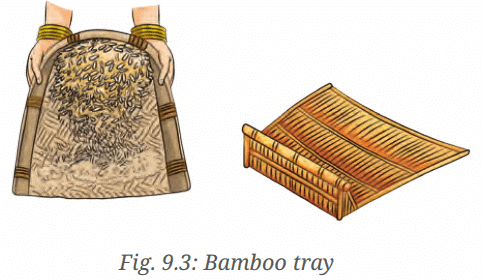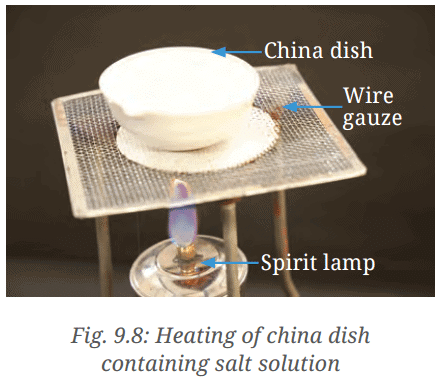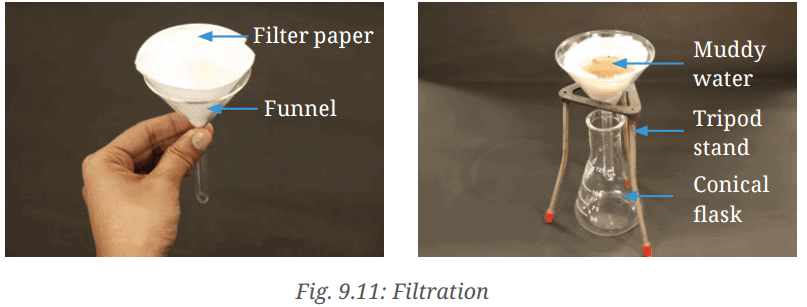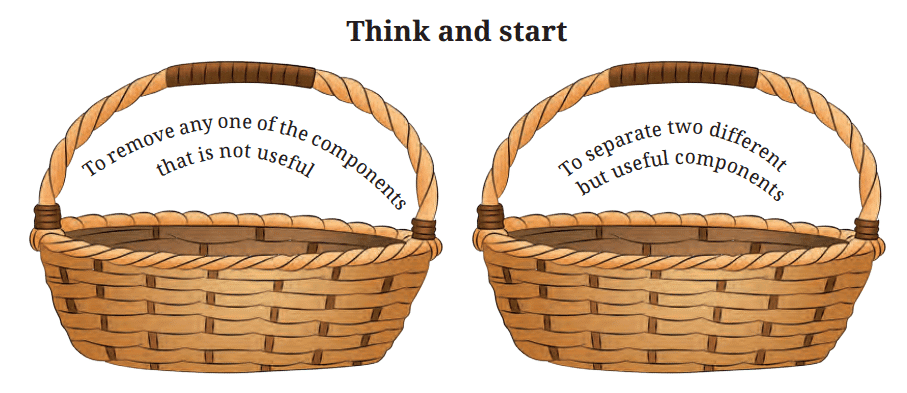NCERT Based Activity: Methods of Separation in Everyday Life | Science for Class 6 PDF Download
Activity 9.1: Let us explore
- Take a handful of roasted peanuts and rub them between your palms. What happens?
- Is it possible to separate the removed skin and the peanuts?
- Now, try blowing it. What do you observe?
- Which of these components—removed peanut skins or peanuts are blown away?
- You observe that blowing air separates the heavier and lighter components.

Q: What happens?
Ans: The removed skin and the peanuts are separated.
Q: Is it possible to separate the removed skin and the peanuts?
Ans: Yes, it is possible to separate the removed skin and the peanuts.
Q: What do you observe?
Ans: You observe that blowing air separates the heavier and lighter components.
Q: Which of these components—removed peanut skins or peanuts are blown away?
Ans: The removed peanut skins are blown away.
Activity 9.2: Let us observe and create
- Have you ever observed white patches on the dark coloured clothes you wear during hot summers? How are these patches formed?
- Take a bowl or any container and fill it half with water.
- Add 2-3 teaspoons of salt into it and stir till the salt dissolves to form a solution.
- Take a small piece of black or dark coloured thick paper and spread a few drops of the salt solution on it (Fig. 9.7a).
- You can also create any art of your choice with this salt solution.
- Allow it to dry and then observe it (Fig. 9.7b and Fig. 9.7c).

- Do you observe some patches on the paper? What do you think is left on the paper? You can feel the presence of salt by touching the paper. Where has the water disappeared? Recall the chapter ‘A Journey through States of Water’.
Q: Have you ever observed white patches on the dark coloured clothes you wear during hot summers? How are these patches formed?
Ans: White patches on the dark coloured clothes are formed when the water in the salt solution evaporates completely, leaving behind the solid mixture.
Q: Do you observe some patches on the paper?
Ans: Yes, you observe some patches on the paper.
Q: What do you think is left on the paper?
Ans: You can feel the presence of salt by touching the paper.
Q: Where has the water disappeared?
Ans: The water has evaporated completely, leaving behind the solid mixture.
Activity 9.3: Let us investigate
- This activity may be demonstrated by the teacher.
- Take some salt solution (prepared in Activity 9.2) in a china dish. If a china dish is not available, another suitable vessel may be used.
- Heat and let the water boil away as shown in Fig. 9.8.

- Caution: Be careful while heating the china dish.
- Allow the china dish to cool down.
- What do you observe? What is left in the china dish?
- Did you get the salt back? You can feel the presence of salt in the china dish by touching the salt with your fingers.
- Observe the figure. Does it answer the question? Can you name the process involved?
Q: What do you observe? What is left in the china dish?
Ans: You can feel the presence of salt in the china dish by touching the salt with your fingers.
Q: Did you get the salt back?
Ans: Yes, you get the salt back.
Q: Observe the figure. Does it answer the question? Can you name the process involved?
Ans: Yes, the figure answers the question. The process involved is evaporation.
Activity 9.4: Let us experiment
- Try to fold the filter paper yourself and make a cone as shown in Fig. 9.10.
- Place it inside a funnel kept on a conical flask and pour muddy water into it (Fig. 9.11).

- What do you observe? Do the mud particles pass through the filter paper?
- The water coming from the funnel will be collected in the conical flask.

- You will get mud as a residue on the filter paper and clear water as filtrate in the conical flask.
Q: What do you observe? Do the mud particles pass through the filter paper?
Ans: You will get mud as a residue on the filter paper and clear water as filtrate in the conical flask. The mud particles do not pass through the filter paper.
Activity 9.5: Let us design and create
Valli goes for a nature walk with her Dadi and collects some water from a pond in a container. She observes some unwanted substances in it. Design and create a working model of water filter using low-cost materials.
Q: What happens when you design and create a working model of water filter using low-cost materials?
Ans: You will get unwanted substances as a residue on the filter and clear water as filtrate when you pour pond water containing unwanted substances into a working model of a water filter made with low-cost materials such as cotton, charcoal, and sand, or a piece of cloth with very small holes or filter paper.
Activity 9.6: Let us play
Write the following phrases on small slips of paper—
- Separating small stones from pulses.
- Churning curd to obtain butter.
- Taking out green chillies from cooked dalia (dish made of broken wheat) or poha (dish made of flattened rice).
- Taking out seeds from watermelon.
- Sorting piles of sawdust and iron nails from a mixed heap of building material.
- Picking marigold flowers from a heap of other flowers to make a garland.
- Separating pebbles from sand.
- Separating coconut pieces from rice flour.
- Separating oil from water.
- Separating salt from salt solution.
Now, take two baskets, each representing one of the two purposes for which we separate substances. Form two teams and see who will get the maximum correct entries.
Basket 1: To remove unwanted components:- Separating small stones from pulses (Handpicking).
- Taking out green chillies from cooked dalia or poha (Handpicking).
- Taking out seeds from watermelon (Handpicking).
- Separating pebbles from sand (Sieving).
- Separating coconut pieces from rice flour (Sieving).
- Basket 2: To obtain useful components:
- Churning curd to obtain butter (Churning).
- Sorting piles of sawdust and iron nails from a mixed heap of building material (Magnetic separation).
- Picking marigold flowers from a heap of other flowers to make a garland (Handpicking).
- Separating oil from water (Decantation).
- Separating salt from salt solution (Evaporation).
Q: What happens when you place the slips in the baskets?
Ans: You form two teams and place the slips of paper with phrases such as separating small stones from pulses by handpicking, churning curd to obtain butter by churning, sorting piles of sawdust and iron nails by magnetic separation, separating pebbles from sand by sieving, separating oil from water by decantation, and separating salt from salt solution by evaporation into two baskets representing the two purposes for which we separate substances, to see who will get the maximum correct entries.
|
69 videos|288 docs|27 tests
|
FAQs on NCERT Based Activity: Methods of Separation in Everyday Life - Science for Class 6
| 1. What are the different methods of separation used in everyday life? |  |
| 2. How does filtration work in separating mixtures? |  |
| 3. Can you explain the process of evaporation and its everyday applications? |  |
| 4. What is distillation and how is it different from other separation methods? |  |
| 5. What role does handpicking play in separating materials? |  |
















